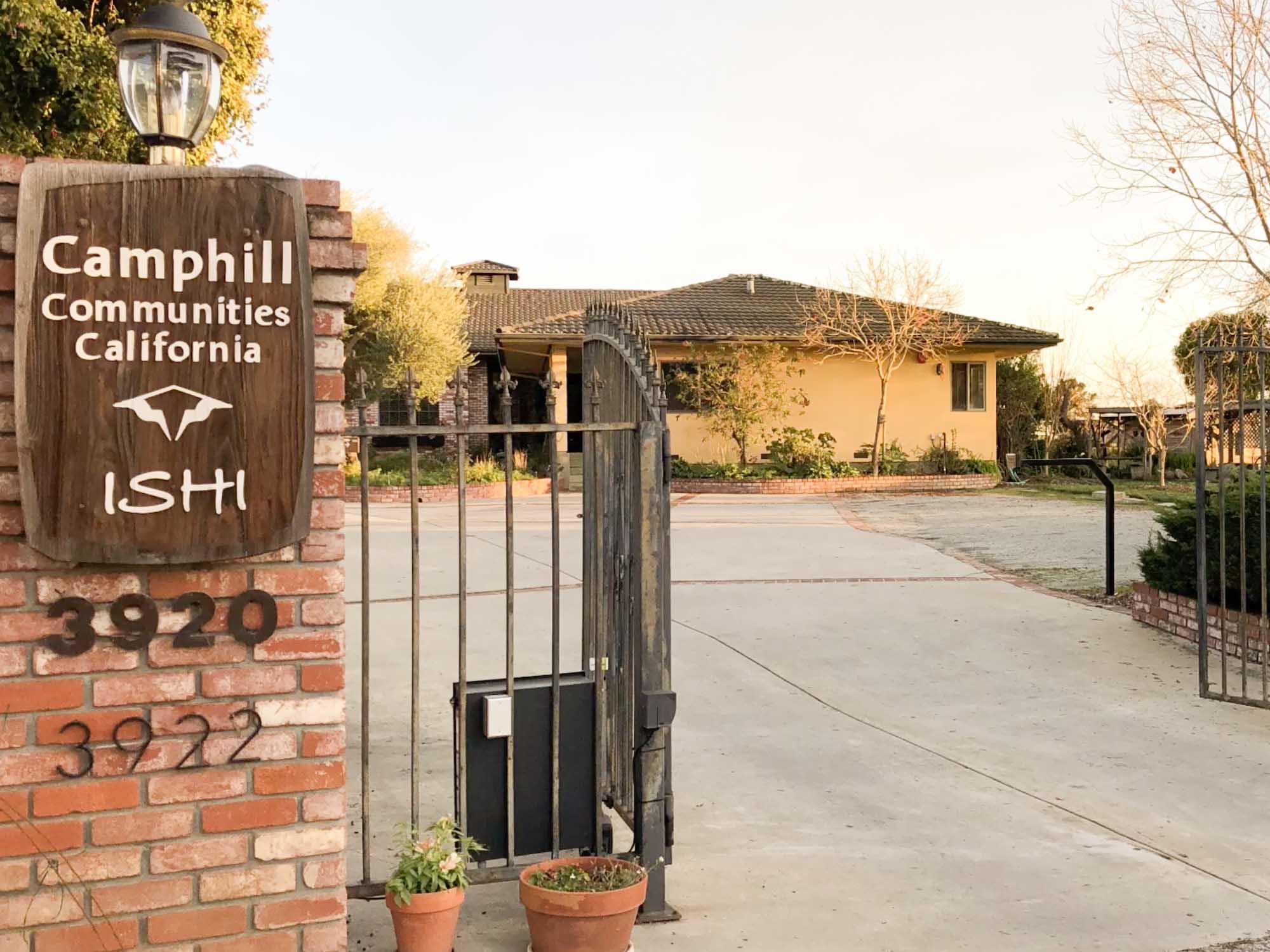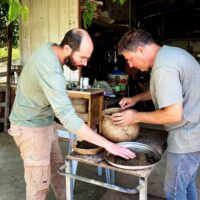Anya Hobley is a co-director at Camphill California, as well as the international delegate for North America to the Council for Inclusive Social Development. In this interview with Charles Cross, conducted at WSIF’s Leadership in Transformation Forum, she reflects on Camphill’s challenges to grow with new generations and in relationship with their local communities.
You are a bit of a Camphill lifer. Would you give us a condensed version of your biography?
I’ve been at Camphill California for 13 years. I went to a Waldorf school and was also a staff child in Camphill as a very young child. My earliest memories are of being in Camphill, living with people of all different abilities. I also traveled a lot, lived in England and California, and dabbled in different things. Today, as the international delegate for North America for the Council for Inclusive Social Development, I get to interface with a lot of different organizations, meet people from all over the world, visit other people’s communities, and become inspired. I feel very blessed.
My roles in the organization at Camphill California have evolved over time. I moved there in 2010 as a single mother of a seven-year-old, and started off with life-sharing and running a small home. From there, I became the administrator for the organization, and then I was asked to take on fundraising. After I became the development director, there was a cohort of about seven of us who were in the emerging position of leadership—the “middle generation”, they called us. They asked us to get to know each other and, amongst ourselves, see who was feeling called to take up the role of leadership as the previous generation was transitioning. Three of us stepped in to take on that duty. It’s changed over time, but the goal is to strive to have a collaborative, consensus-based leadership that’s transparent and includes different layers of the organization.
Can you share some of the challenges in your own community that you see reflected in the bigger world?
When I first arrived in the community, there was a sense of an “us” and a “them”, the inside and the outside. The people who were life-sharing were ascribed a certain value. Those people were real “Camphillers”, and the people who were coming in and working at the periphery were kind of outsiders: they were part of the organization, but they also felt a little removed. Between the younger and older generations there was the sense that if you came as a young volunteer, if you were a short-term co-worker and not really invested, then you weren’t really included in the decision-making. You were there for an experience and to support the community—not to question or take on responsibility.
In contrast, I had been a young co-worker in Ireland in a community that at that time was very collaborative, with an open door to any meeting from day one and real income-sharing. Previously, I had experienced a lot of regulations. There, I thought, “Oh wow, people trust me, they give me responsibility, they’re asking for my opinion.” And so from day one, I felt very at home, as if, “This is my community.”
And you could see how people grew into their roles and stayed on. When I first came to Camphill California, there was a feeling that the young people who came didn’t want to stay on. So there was a question, “Why don’t people want to stay?” Well, maybe they feel “othered” or they feel there’s too much of a distinction. You don’t want to overburden people, but you want to invite them in. If there is curiosity, if there is interest, there’s a way to foster that. We had a social therapy training, which was one way that people could get interested and stay on longer and learn about the values of Camphill, and that was later formalized in the Camphill Academy training—so it’s much clearer now. That’s actually helped people to stay on longer and given clarity to their roles, their objectives, and their practicum. We also did away with some of the terminology of “long-term” or “short-term” coworkers, and those who made a three-year or longer commitment started to be included in meetings.
Because we’re a small community, we sometimes need people to step out of their comfort zone and take on running a house or a crew or a workshop, maybe before they are ready. We try to invite them, “Would you like to try this? Would you like to partner with someone to run a house?” That way, people feel they need to step up or step into responsibility but with the right support.
At a certain point, we were given feedback by younger people: “We are all given mid-year and end-of-year reviews and feedback, but long-term care and co-workers don’t have that. That’s not fair.” It came from a place of frustration and questioning that forced us to self-reflect. As an organization, we are able to really learn from that. It’s so important to be able to do that and not say, “Oh, this is just the way it is,” but to say, “Actually, this person has a good point and we do need to be holding ourselves accountable.”
But what does that look like? So, we came up with our own tool called the Reflection Circle, which is a process where you ask 3 or 4 of your peers to sit in a circle with you and have a meeting. You fill out a self-reflection form before you come, and you ask everyone in the long-term carrying circle and maybe those who work directly with you or in the office to fill out an anonymous form. You have a facilitator for your meeting, and that person brings all the community feedback from different areas: your work life, your home life, and your cultural-spiritual life. How are you doing in these areas? Are there things that you should be doing differently? Are there roles that people feel you’re suited to or should not be doing? And often the person who shares their self-reflection comes to those same realizations. But it’s an opportunity every single year for these long-term coworkers to do this reflection and have it reflected back to them. There’s no waiting until there’s burnout or addressing something too late. That has been a really helpful tool: self-knowledge for the individual and for the organization. We really strive for inclusivity, transparency, and accountability.
The younger generation is making its presence known and taking leadership in Camphill. What other aspects of generational change do you see, and what demands for leadership do you see for the movement moving forward?
It’s important that people don’t see leadership just as being in a position of having arrived, or power-over, or a need to control, but that it’s real servant leadership. What I’ve learned through the Leadership in Transformation forum is a capacity to host one another: that we create spaces where people feel invited into relationships, that they feel heard. Also, as a leader, it’s important that we don’t have an unrealistic expectation of how we’re supposed to show up, right? It’s so important to be vulnerable, to be honest, and to be accessible. You want people to not be afraid to come to you, and you want people to be able to question you, to bring new ideas. I’m 45 and I’m already thinking of emerging leaders: “How can I empower this person to take this on?” Because it’s clear to me that it’s not going to serve the organization if I say, “I’m in charge and you’re going to do it my way.” No, it’s continually renewing the organization by having people feel like it’s their organization, that they can love what they do, and they can bring their own gifts. So sometimes you need to invite someone to take on responsibility when they don’t feel quite ready. At other times, you need to listen to someone when they’re bringing something. It’s a constant process of refinement, and it’s a process of growing without being too attached to what Camphill is in the world. There is a big question right now about the future, especially with the constraints of authorities or the rules of a place, as well as with the difference in generation, with terminology and accessing the content. But at the end of the day, we’re all trying to be more human. It’s about asking, “What is this impulse I’m a part of? What is the world asking for, not what do we identify as?” So, it’s important to continually renew who we think we are, both on an individual and an organizational level.
It seems there are a lot of challenges in the meeting space between Camphill communities and the bigger worlds they’re a part of. How are you approaching those challenges?
In the last few days here at Ruskin Mill, we’ve learned about the genius loci, which is the spirit of a place. Where do you find yourself? Each Camphill is not an island or even a candle on the hill, which is what it needed to be in the early days: a place of protection, somewhere special. Now, there’s a question of how we actually immerse ourselves in our place and be a part of that landscape. We had a group of students visit from the University of San Diego last summer, and they were asking, “Why are your demographics not more diverse?” And it was a really good question. Maybe it’s because people hear about us through word of mouth, and maybe the service coordinators and regulatory agencies need to know more about us. So, we always need to be doing a better job with outreach, and to meet people. We have beautiful spaces—why not host more people here in our community? We have native tribes who live very close by, and we grow plants like sage—there are resources that should be shared. They don’t belong to us, right?
We need to continually remind ourselves to widen our circle. And that’s been part of my main mission; bridge building, collaboration, and awareness. When I first moved to Camphill California, the people down the road from us—the people in our own neighborhood—didn’t know what we did. They didn’t know the people that we worked with. It’s really important not to have this impermeable membrane, right? It’s important to maintain your identity and to be able to name what it is that you value, what it is that you are, but also to be able to encounter and have an interest in and collaborate with different organizations or people or demographics. We still have far to go in that regard, but every year we do meet new people, and people around us get to know us better. We collaborate with local farms and host events and go to other people’s events. All of this allows us to continue to grow.
Image Entrance to the community of Camphill California in 2018. Photo taken from the Video on the Youtube channel “camphillcalifornia”





